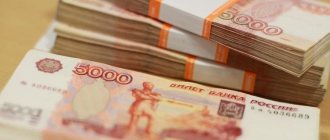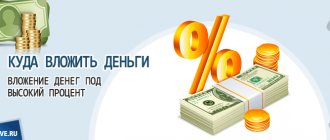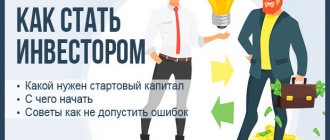Despite the abundance of financial institutions, banks still remain the most popular place where you can not only save, but also increase your money. Currently there are more than 20 trillion rubles in deposits. About 75% of them are placed in banks included in the top 50 largest banks in the Russian Federation. Approximately 40–50% of these funds are now in Sberbank. Just imagine how many millions of people depend on one institution!
But you won't find high interest rates at large banks. They are not interested in this, since they earn more money on loans. But small banks sometimes provide very favorable conditions. And the logic here is simple - they are simply developing a client base and they need money from which they need to issue loans. To choose a bank, we need to understand all the issues of profitable investment of money at interest in 2020.
Expert opinion
People prefer to keep their money in banks that have been proven for decades. Experts explain this by saying that people:
- lost trust in other financial institutions;
- lost confidence in the future;
- they understand that inflation will “eat up” their entire nest egg;
- want to save for their retirement.
Since 2020, there has been a strong renewed interest in deposits. Most often, Russians choose stable banks that have been operating for decades. The reason for this is simple: they are not afraid of any crisis. Also, such banks will simply be afraid to commit large frauds, otherwise they may be deprived of their license. And the fears are not at all groundless. In 2020, about 10% of banks (about 80 institutions) lost their licenses; by 2022, their number will be reduced to 500. And by 2030, there will be less than 200 of them.
Defining the goal
Always start with a goal. A bank deposit is the least risky and least profitable financial instrument. Why is it needed at all? Oddly enough, there may be several answer options, for example:
- “To save the money you have.” Goal: save.
- “To live on the interest from a bank deposit.” Goal: earn and spend.
- “To save up for a car.” Goal: accumulate.
- “To place temporarily free investment assets.” Goal: earn and reinvest.
What does this matter, you ask? Direct. The choice of investment depends on the purpose.
In the first case, you should choose a classic “long” savings deposit in a super-reliable bank from the TOP-10.
In the second - a “long” deposit with the possibility of partial withdrawal and simple interest with periodic payment.
In the third - a medium-term replenishable deposit with interest capitalization in a bank offering high returns.
In the fourth - a “short” deposit with interest capitalization and the possibility of extension.
Who should you trust with money?
Do not believe loud promises - they are almost always a hoax. It is better to choose an institution with low interest rates, but with a good reputation. As they say: the slower you go, the further you will go. Pay attention to:
- Bank positions. Refer to the lists of the Central Bank of the Russian Federation, the National Rating Agency, Forbes and national ratings. Choose those institutions that are among the top everywhere.
- Financial condition of the institution. Follow the basic rule - the bank must have increasing liquidity. In simple terms, if an institution issues too many loans and almost no deposits, then it is better to avoid it.;
- Founders and managers. Do not trust money to people with a bad reputation and dubious past. It is likely that they may take up their unclean deeds again.
- Whether the financial institution is a participant in the deposit insurance program. If not, don’t invest a penny here! If he participates in the program, then you should not deposit more than 1.4 million rubles. It is better to break a large amount into 4-5 small ones and place them in several banks. This way you will be sure that at least part of your money will remain with you.
Interest, interest money and interest rates [p.70]
INTEREST MONEY, or INTEREST, is the amount that is paid for the use of money. This is the absolute value of income. [p.71]
Calculate the interest paid for using a loan of 1 million rubles. within six months. The loan rate is 60% per annum. [p.107]
The functioning mechanism of the credit market includes a set of forms and methods for the purchase and sale of loan funds, including the principles for calculating interest on loans and various types of interest rates. Income from the provision of funds for temporary use, i.e. interest is the end result of credit operations. Interest (interest money) is income from the lending of capital in various forms (loans, loans, investments, etc.). The interest rate characterizes the intensity of interest accrual. [p.600]
Interest (interest money) - 1) the amount paid for the use of borrowed funds 2) income from the provision of capital in debt in various forms (loans, credits, investments, etc.). [p.735]
Rich dad often referred to the earned income you receive from your paycheck as 50 percent money. The reason for this, he saw, was that no matter how much money you earned, the government always somehow took at least 50 percent of it, and sometimes more. If you make $50,000 a year today, at least $25,000 will go to the government, and most of it before you even get your hands on it. Even after receiving the remaining $25,000, tax collections continue. As most people know, you are taxed when you earn money, spend it, save it, invest it, and even when you die. In fact, your taxes upon death could be very high if you have not properly prepared for the event. As rich dad often said, if you don't have a plan for your money when you die, the government does. From rich dad's perspective, it doesn't make much sense to work hard so that the government takes at least 50 percent of your hard-earned earnings. [p.55]
A few years ago the tax percentage was even higher than 50 percent. And while this percentage has been falling over the past few years, to compensate for it, many loopholes have been eliminated that allowed the money to be hidden. The point is, when rich dad was still working for a salary, he often referred to earned income as 80 percent money because that's how much the government took from the income of highly paid employees.) My poor dad didn't understand that there were different types of income, and so worked hard for 50 percent of the money and then bought a bigger house to take advantage of tax breaks he never actually had. Instead of learning more about the different types of income, my dad followed the beaten path to school, hoping to advance in his job and get a raise in salary. In other words, he worked hard, studied hard, earned more, and paid more and more in taxes because he worked for 50 percent of the money. Rich dad had some difficult moments trying to understand people who wasted their lives looking for a better paying job or waiting for a raise. He often said: When you get a raise, the government gets one too. In his opinion, spending time working for 50 percent of the money is not financially sound. [p.55]
Today, most people try to retire using what my rich dad called 20 percent money, which is capital gains or appreciation in stocks and, in some cases, real estate. Just a few years ago, this rate was much higher, which means that working for capital gains today has become even more reasonable. When you hear a politician say My opponent gives [p.55]
Many people are financially smarter and don't try as hard to earn earned income. Many people ask employers for stock options in the company they work for - these options can become 20 percent money if the company does well (although some of them are considered earned income, subsequent increases in value can become 20 percent money ). True, a stock option may not pay you a penny if the market price of the company does not increase. The key here is that people are starting to understand the differences in tax advantages and leverage ratios for different types of income. The gap between the haves and have-nots is growing steadily because most people are unaware that there are different types of income and work hard to earn the wrong type of income. [p.56]
One of the reasons Kim and I retired early was our constant use of tax deferrals, or what rich dad called 0% money. This was money received from investments and the sale of real estate, which is not subject to taxes immediately; in this case, the payment of taxes can be deferred for a period of time, the duration of which we choose ourselves. For example, we shell out $5,000 in cash and buy a house for $50,000. Two years later we sell it for 100 thousand dollars. We made a profit from the sale of this real estate - 50 thousand dollars, but decided not to pay tax on the profit from the sale of real estate - that is, 20 percent, which would be approximately 10 thousand dollars. Instead of paying that money, as we would have had to do if we had received the same amount of income from stocks or a mutual fund, we deferred our tax payments and racked up $55,000 (50,000 from home price appreciation plus a down payment on $5,000) and put it all into our next investment. In other words, in two years we made 1,000 percent of the profit without paying any taxes. We legally received a deferment on our taxes and thus use the government money to purchase an even larger apartment building costing $330,000. To do this, we used bank loans and some seller's securities to help raise the remaining $275,000 that we didn't have. In this case, we not only used DDL (other people's money), but also government money to help us retire young and rich. Between 1988 and 1994, we used this tax strategy many times. [p.56]
Today, employees pay for most of life's pleasures with after-tax dollars. For example, most employees are forced to pay for their car with them. A business owner is allowed to pay for his car with pre-tax dollars if he uses his car for business purposes and it meets certain other conditions. If you work for 50 percent money, your car may cost much more than your boss's car, even though your boss has a higher class. Even things like football tickets, vacations, restaurants, daycare fees and more can often be paid for with pre-tax dollars. The business owner can pay for all of this with pre-tax dollars, while the employee pays for it with his or her after-tax dollars (note that these expenses must meet the criteria for a business expense, and there may be a number of restrictions). So not only do most people in America work for 50 percent pay, they pay for life's necessities with money cut in half. When rich dad explained this difference to me, I immediately realized that the price of security that comes with being an employee was too high. [p.58]
The question is: what type of money are you working hard for? If you work for 50 percent money, you will have to work harder than a person working for money that is not so expensive, and the most expensive money is in the R quadrant. Ask any accountant and they will tell you that they can hardly do anything for you in the E quadrant - the government has closed most of the loopholes there. For people in the E quadrant, the employee quadrant, the best tax benefit is their 401(k) retirement plan. For example, I have it. Regardless of whether a person's goal is security, comfort, or wealth, they should get the most out of their 401(k) retirement plan. For many people in the E quadrant, this is the only loophole available to them. [p.59]
For people who choose to keep all their money in the bank and believe that this is smart, their savings work like 50 percent money. I also have money in the bank, but I don't think bank savings are a very smart solution. It's just part of my security plan, not my plan to get rich. This is true, although I do not think that when my savings work like 50% money, and are also eaten up by inflation, this is reasonable. [p.60]
In subsequent chapters, you'll learn why the advice to go to school, get a job, work hard, save money, contribute to your 401(k) may be the worst advice from a tax perspective. At each of these stages of life, this advice implies working for 50 percent money. My poor dad was poor because that was the only advice he could give to himself and his children. This was his only reality when it came to money. [p.60]
Earned income 50 percent money [p.62]
Portfolio income 20 percent money [p.62]
Passive income 0 percent money [p.62]
The reason Kim and I were able to retire early is because we worked hard to build a business and acquire real estate. This plan allowed us to work less and less and get more and more. We didn't work for money. We worked to build, buy, or create assets as rich dad advised. We were not interested in high-paying jobs and salary increases. We were not interested in work for hire, with a low leverage ratio, for 50 percent money. We didn't think it was smart; on the contrary, we thought it was much riskier in the long run. In subsequent chapters, I'll go into more detail about how you can work to create more assets with less risk and higher financial returns. But I warn you that you will have to work for free to learn how to acquire such assets. I'm warning you about this now because working for free to study is something that very few people do. And that's why very few people can retire young and rich. [p.63]
People who say work hard, save money and invest in a 401(k) plan are working for 50 percent money. Once you retire and start taking money out of your 401(k), it will be taken away from you in taxes at the rate of your earned income, so it will become 50% money, as my rich dad would call it. Interest from savings is also taxed at the same rate as earned income. [p.85]
Rich dad believed that most people needed to learn how to save money. But he himself did not do this. He said, “Focusing on saving money takes up too much of my time, and there is not enough leverage in this business,” and added, “The money most people accumulate is money left over after taxes.” To save $10, a person would actually have to earn $20, since that is earned income, or 50 percent money. Apart from this, the interest you earn on your savings also causes taxes to increase. [p.85]
Interest-bearing money -F- 20.2. Simple interest -F-20.3. Compound interest -F- 20.4. Calculation of financial payments [p.308]
Interest money, or interest, is the amount that is paid for the use of money. This is the income of the owner of the funds. The following types of interest are distinguished [p.315]
A clear understanding of the basic concepts of financial mathematics is necessary to understand all subsequent material. The main one of these concepts is interest money (hereinafter referred to as interest), the definition of which is the essence of most financial calculations. [p.84]
Interest (interest money) is the amount paid for the use of funds. [p.65]
The material is presented according to the already established classical standard. The concept of interest money, simple and compound interest, discounting (taking into account changes in the value of money over time in connection with the possibility of receiving interest), equivalence of payments, annuities (a series of regular payments) and perpetual annuities is given. These concepts are used to describe elements of practical financial activity, such as issuing bills and their purchase and sale, amortization (constant payment) of debts, purchase and sale in installments, formation of target funds, calculation of investments, handling of the simplest securities-bonds, definition their market price, depreciation and depreciation of equipment, determining the price of shares. [p.4]
Chapter 1 INTEREST MONEY [p.7]
Any owner who has an apartment or garage that he does not use can rent them out, receiving a certain fee for this. Likewise, a person with spare money can lend it to another person (or, to use a more general term, invest it) for a certain fee. The return on invested capital, or, in a more narrow sense, the reward for the use of money, is called interest money, or interest. The amount of money loaned is called principal or capital. Typically, a loan is given for a certain time - a period. The amount of interest and principal due at the end of the period is called the total. In general, the ratio of interest for a certain period to the principal amount (capital) is called. interest rate. This rate is most often expressed in the form of a percentage; in calculations, equivalent decimal (less often natural) fractions are used. When concluding specific transactions, another name is usually used to indicate the rate of interest - interest rate. [p.7]
How many quarterly payments of 3 million rubles? will be required to pay for the purchase of a car worth 45 million rubles, if 8 million rubles are paid. cash and interest are accrued at the rate /12 = 5 °/° What will be the final payment [p.232]
INTEREST, INTEREST MONEY AND INTEREST RATES [p.5]
While I recommend everyone have a 401(k) plan and contribute as much as possible to it (assuming you're legally entitled to one), I do see one very significant downside to it: even though you're saving money, what if you If you're lucky, your savings will grow without being subject to the 20 percent capital gains tax—yet when you retire and start withdrawing money from your savings account, you'll be hit with a 50 percent tax on earned income. You think you're investing in portfolio money or 20% money, but when you start cashing it out, you're still charged the same earned income tax. In other words, although you are investing in low-tax
Money from paid work is the most highly taxed income. That's why I don't like that the young talented people I meet in educational institutions are happy that they will soon get a well-paid job. A young person with such an attitude will face increasingly hard work for 50 percent money. One fine day he will wake up and realize that he is 40 years old, and he is still sitting in the same place, in his well-paid job, and some of his friends have already surpassed him financially. The reason why hardworking people fall behind financially in adulthood is because they spent their entire lives working hard for their earned income. They worked hard for salary increases and benefits. [p.61]
Features of an ideal deposit
When choosing a deposit, pay attention to:
- Currency. If you have small amounts, it is better to open an account in rubles. But if you have a lot of money, feel free to choose a multi-currency deposit. If you decide to deposit $200–300 dollars, you will not experience any income. But, if you invested $30,000 in the bank, you will receive a significant profit within a year.
- Interest rate. There is no need to pay too high interest rates. This could be a scam to attract customers. Do you really think that the bank is ready to give you 20-30%? This is completely unprofitable, he is simply trying to take your money and “go off into the sunset.” A more realistic interest rate is around 6–8%.
- Deposit term. Deposits can be fixed-term or permanent. After the deposit expires, the funds are most often transferred to a savings account. But you won’t earn money from it, since the interest rate there is usually 0.01%.
- Replenish your account or withdraw funds. If it is important for you to know that you can withdraw money at any time, then choose only those deposits where this is possible. If in its terms and conditions it is not signed anywhere, you should wait until the end of the deposit. Even if the bank collapses, you will not be able to withdraw money until the end of the deposit.
Choosing a program for placing money at interest
When deciding which bank is best to put your money in, first think about what type of deposit you need. Only after this can you start looking for a bank that services just such a program at a good interest rate.
It is also worth weighing the possibility of automatic renewal
Deposit program options:
- classic contribution. You deposit money into the account and receive interest from the placement monthly or at the end of the term. No transactions are carried out on the account. The rates for such programs are the most profitable;
- replenished. If you want money at interest in the bank with the goal of saving for a specific goal, this program will be convenient for you. You will be able to regularly top up your account, thus increasing your profitability;
- with the possibility of removal. Such programs are the most inexpensive, so you should choose them only if you understand that you may need funds from the deposit. You can only withdraw money up to a certain balance;
- short-term and long-term. According to some programs, you can leave money in the bank for at least 1 month, according to others for at least 1 or even 3 years;
- with interest paid regularly or once a month.
You can deposit money in the bank with the extension option activated. In this case, when the period for placing funds has passed, the system will automatically extend the agreement for a similar period.
Many banks allow you to deposit at interest using capitalization. When this option is activated, the client is regularly accrued interest, but it is not transferred to the depositor, but is added to the principal amount of the deposit, increasing profitability.
Table of bank offers for deposits and deposits
So that you don’t get confused when studying the most popular deposits, we have collected them in a table. Here you can find the best offers for deposits in rubles in 2020.
| Bank's name | Rate (% per year) | Name of deposit | Deposit term (months) | Min. deposit amount (thousand rubles) | Possibility of replenishment/withdrawal | When is interest paid? |
| Sberbank | 5,44 | Save | 36 | 1 | no no | Monthly |
| Vanguard | 6,25 | Base | 12 | 10 | no no | Monthly/end |
| Raiffeisenbank | 7 | Great start | 12 | 100 | no no | Monthly |
| Opening | 7,55 | Reliable | from 1 to 24 | 50 | no no | Monthly |
| Rosselkhozbank | 8,5 | Profitable | from 1 to 48 | 3 | no no | Upon completion |
| VTB 24 | 8,4 | Growth time | 36 | 30 | no no | Upon completion |
| Alfa Bank | 6 | Potential+ | — | 10 | Yes Yes | Monthly |
| Loko-Bank | 9% | Sounds profitable | 36 | 50 | Not really | Monthly |
| Russia | 6,8 | Scarlet Sails | 12 | 3 | frequent/no | Upon completion |
| MTS Bank | 7,8 | MTS BIG | 12 | 50 | Not really | Upon completion |
| Home Credit Bank | 8 | 18 months Plus | 18 | 1 | Not really | Upon completion |
| Novikombank | 6,26 | Growth-online | 13 | 1 | Not really | Upon completion |
| Gazprombank | 8,3 | Gazprom is your success | 36 | 50 | no no | Monthly |
| Zenith | 9 | Successful | 16 | 30 | no no | Upon completion |
| Promsvyazbank | 7,4 | My income | 4-24 | 10 | Not really | Monthly |
| Renaissance | 6,91 | My income | 1-36 | 30 | no no | Upon completion |
| ICD | 8 | MEGA Online | up to 36 | 1 | Not really | Monthly |
| Investtorgbank | up to 8 | Long-term ITB | 75 | 50 | Not really | Upon completion period |
| Tinkoff | 7,5 | SmartVklad | up to 24 | 50 | Yes Yes | Monthly |
| Baltinvestbank | 6,7 | Champion online | up to 12 | 10 | Not really | Monthly |
| Sovcombank | 7,6 | Maximum income | 1-36 | 50 | Not really | Upon completion |
| Oriental | 8,1 | Summer mood | 3-12 | 30 | no no | Upon completion |
How to put money in a bank at interest
If you have chosen which bank to deposit your money in, you can proceed to opening a deposit account. Many banks have simplified the process of opening deposits; they accept applications for opening accounts from citizens via the Internet. In this case, the opening process will be like this:
- Choose where to put your money by analyzing deposit programs. Compare at least 10 similar offers from different banks.
- Submit an online application, indicating your city and contact information.
- The manager will call you back promptly. He will tell you at what percentage you can deposit money on the terms you are interested in, give advice and make an appointment at a branch convenient for you.
- You come to the bank, bringing money with you, and sign an agreement.
Modern technologies make the investment process convenient.
The job is done. When you visit, you will be given access to online banking, through which you can monitor your account. This is especially true if you have chosen a replenishable deposit.
about the author
Irina Rusanova - higher education at the International East European University in the direction of "Banking". Graduated with honors from the Russian Economic Institute named after G.V. Plekhanov with a major in Finance and Credit. Ten years of experience in leading Russian banks: Alfa-Bank, Renaissance Credit, Home Credit Bank, Delta Credit, ATB, Svyaznoy (closed). He is an analyst and expert of the Brobank service on banking and financial stability. [email protected]
Is this article useful? Not really
Help us find out how much this article helped you. If something is missing or the information is not accurate, please report it below in the comments or write to us by email
How to open a deposit
Regardless of the chosen financial institution, the client will need to follow a simple algorithm of actions to open a deposit. First of all, you need to familiarize yourself with the offers and choose the most suitable option, guided by the above criteria. After this, the consumer only has:
- Visit the nearest bank branch.
- Notify the employee of your desire to open a deposit.
- Fill out the necessary paperwork and sign the agreement.
- Deposit funds into the account.
If the client already has any product of the chosen financial institution, he can often take advantage of online banking capabilities to open a deposit remotely and receive more favorable conditions.
What is a deposit?
A deposit is a deposit in a bank on which the bank accrues additional funds - interest. Their value depends on what agreement underlies the deposit.
We recommend reading: 5 facts about online deposits
Deposits can be opened by individuals or legal entities, enterprises and organizations. They are beneficial for banks because the invested funds are used by them to issue loans and carry out various monetary transactions and operations.
Interest (the client's benefit) is calculated from the profit received by the bank from the invested money.
Features of storing funds on various types of deposits
The method of withdrawing funds largely determines the profitability of the deposit for the bank client. Which one should you choose?
Time deposits are limited to a certain period of time. During this period, you cannot withdraw the invested funds. If you withdraw before the agreed date, all accumulated interest is forfeited. Term deposits usually charge a maximum interest rate.
The deposit on demand can be used if necessary at any time. There are no restrictions on the amount. This is simply a form of storing money.
The monetary benefit for the client is minimal, but there is no separate fee for renting a safe deposit box, and savings are always available at the first request.
There is another type of deposit. They require the constant presence of a certain amount in the account.
We advise you to read: Where is the best place to store money: expert opinions
All funds above this amount are always available, as in the case of a demand deposit, but the minimum balance should not change. All funds can be withdrawn only after the expiration of the contract. If the minimum balance was reduced earlier, then all interest on the deposit is lost.
Three enemies of savings
First of all, according to the expert, three enemies of the safety and security of savings should be identified. This :
— vulnerability of the banking system. Financial organizations regularly leak personal data of their clients, which falls into the hands of fraudsters, who steal Russians’ money; — inflation. Although the growth rate of consumer prices in Russia has slowed down, even 4% inflation “eats up” savings; - unscrupulous banks. There are financial organizations that do not take into account depositors’ money in official reports; they do not pay contributions to the Deposit Insurance Agency (DIA), which means that when a bank’s license is revoked, clients receive less money than they kept on deposit. Or they get nothing at all.
It's about the bank. How much money have Russians saved? More details










